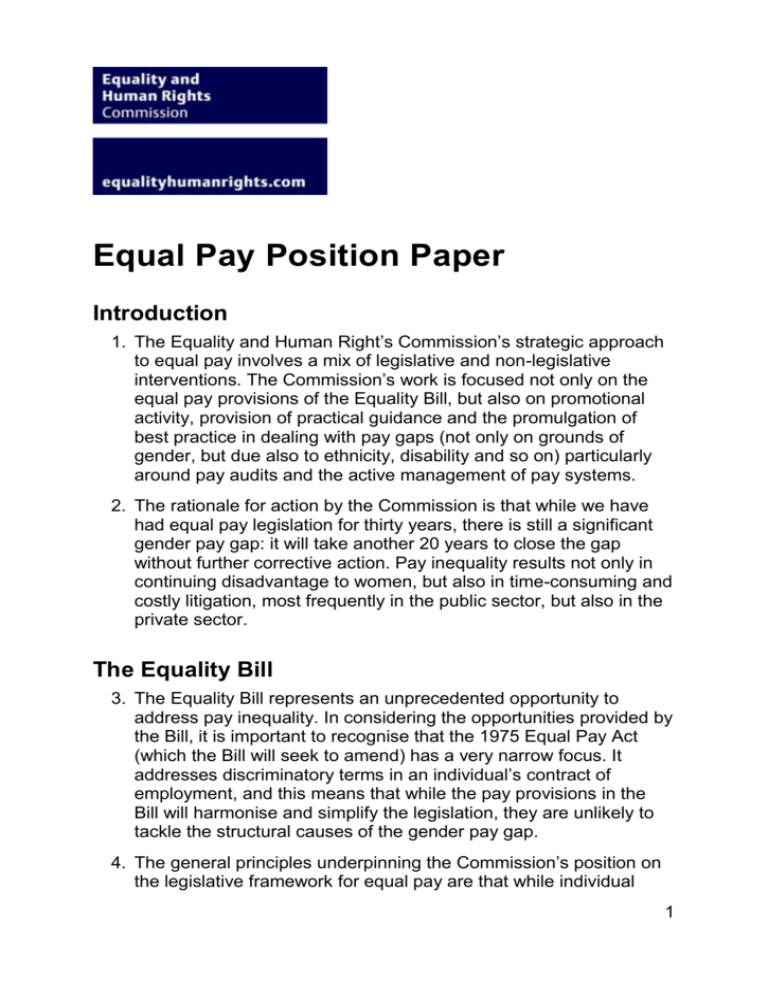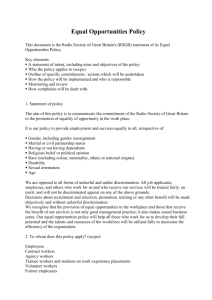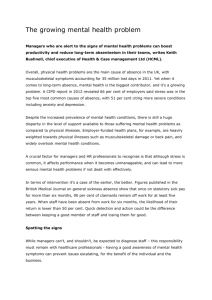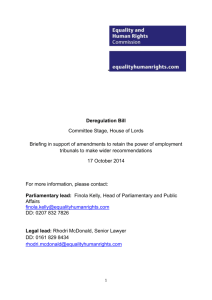Equal Pay position paper - Equality and Human Rights Commission
advertisement

Equal Pay Position Paper Introduction 1. The Equality and Human Right’s Commission’s strategic approach to equal pay involves a mix of legislative and non-legislative interventions. The Commission’s work is focused not only on the equal pay provisions of the Equality Bill, but also on promotional activity, provision of practical guidance and the promulgation of best practice in dealing with pay gaps (not only on grounds of gender, but due also to ethnicity, disability and so on) particularly around pay audits and the active management of pay systems. 2. The rationale for action by the Commission is that while we have had equal pay legislation for thirty years, there is still a significant gender pay gap: it will take another 20 years to close the gap without further corrective action. Pay inequality results not only in continuing disadvantage to women, but also in time-consuming and costly litigation, most frequently in the public sector, but also in the private sector. The Equality Bill 3. The Equality Bill represents an unprecedented opportunity to address pay inequality. In considering the opportunities provided by the Bill, it is important to recognise that the 1975 Equal Pay Act (which the Bill will seek to amend) has a very narrow focus. It addresses discriminatory terms in an individual’s contract of employment, and this means that while the pay provisions in the Bill will harmonise and simplify the legislation, they are unlikely to tackle the structural causes of the gender pay gap. 4. The general principles underpinning the Commission’s position on the legislative framework for equal pay are that while individual 1 rights must be guaranteed and must provide for a timely and effective remedy, litigation is not the answer to tackling pay deficits. Employers must commit to ensuring that their pay systems provide for equal pay, but for this to be fully effective there must be dialogue between employers, (both public and private), employees, and unions on how to achieve this; and we believe that government has a crucial role in providing a legislative framework that encourages collaborative and effective remedies. The gender pay gap 5. The gender pay gap - as measured by the median hourly pay excluding overtime of full-time employees - widened between 2007 and 2008. The gap between women's median hourly pay and men’s was 12.8 per cent, compared with a gap of 12.5 per cent recorded in April 2007, when it had been at its lowest since records began. When calculated using the mean (the Commission’s preferred measure), rather than the median, women’s hourly pay, excluding overtime, was 17.1 per cent less than men's pay, showing an increase on the comparable figure of 17.0 per cent for 20071. For women working part-time the gap was 35.6%. National statistics cannot measure the gender pay gap within an establishment. This can only be done by employers themselves. Why the gender pay gap matters 6. While the pay gap matters to women – the EOC calculated that an average woman working full-time would lose £330,000 over the course of her working life, as compared to an equivalent male – it has wider economic and social consequences. At a macroeconomic level, the Women and Work Commission (chaired by Baroness Prosser) estimated that closing the gender pay gap would result in an increase to GDP of £23 billion. Unequal pay may also imply low pay, which is a substantial cause of women’s poverty (in work and in retirement), and impacts not only on women, but also on their children. Causes of the gender pay gap 7. Despite women now accounting for almost half the labour force, and the significant improvement in women's educational performance and entry rates to higher education, major structural differences persist in patterns of male and female employment that 1 Annual Survey of Hours and Earnings 2008 2 have a strong influence on the gender pay gap. The causes of the pay gap include: Women’s propensity to work part-time: as the responsibility for looking after children and other dependents falls on women more than men, almost half the jobs occupied by women are part-time2. Switching to part-time work often involves occupational downgrading, with highly qualified women working well below their skill levels. It is still the case that in the main, part-time working means low paid, low skilled work, and that in general there has been a reluctance to restructure senior jobs so as to make them available for flexible working and job-sharing. Occupational segregation: women are crowded into the ‘5 Cs’: catering, cleaning, caring, clerical and cashiering – and fewer women are managers or hold senior-level positions within organisations. According to PWC, the proportion of women in senior management posts in FTSE 350 companies has fallen from 38% to 22% since 2002, for example. Persistent undervaluation of women’s work, as compared to that done by men: we pay people more for looking after our cars (£9.72 an hour) than for looking after our children (£7.64 an hour)3. Discrimination in pay systems: factors peculiar to the UK labour market make it particularly prone to structural pay discrimination – the relatively low levels of trade union penetration (especially in the private sector); the reduction in centralised collective bargaining; the lack of any legal standing for the outcome of negotiated solutions to equal pay, and the UK’s unusually wide pay dispersion, coupled with the haphazard growth of many workplace systems of pay determination, all foster a lack of objectivity in setting rates of pay. 8. The debate about the causes of the gender pay gap is highly contested. Some commentators insist that the differentials are not about overt discrimination, but the jobs people do and that 'men's jobs' have disadvantages, for example they are more insecure or dangerous. It is argued the gap may also reflect statistical anomalies: in Britain more women work part-time than in the Southern European countries, exacerbating the reported pay deficit. Finally, it is suggested that as girls now out-perform boys at 2 3 Defined as 30 hours or fewer per week ONS (2006) Annual survey of hours and earnings 2006 3 school, the gender pay gap will close without the need for corrective intervention. EHRC action to tackle the gender pay gap 9. Action to tackle the gender pay gap needs to address the underlying structural causes. That is at the heart of the Commission's strategic approach. As well as seeking to influence the pay provisions of the Equality Bill, the levers used include research, intelligence-gathering and monitoring, as well as compliance and enforcement action alongside strategic legal interventions. The Commission is also represented on the reconvened Women and Work Commission, chaired by Baroness Prosser. The legislative framework 10. Turning to the legislative framework, it is important to recognise that the 1975 Equal Pay Act is directed only at discriminatory terms in an individual’s contract of employment. The Act implements the right to equal pay contained within the EC Treaty and relevant Directives. In applying, interpreting, or amending the Act, the courts and the government must take account of EU legislation and case law. 11. Equal pay claims now make up one in three of the claims being filed with the Employment Tribunal, providing a startling illustration of the complaints-led nature of equal pay law. While the recent explosion of cases has given urgency to the calls for reform of the equal pay legislation, concerns that the Act was not working effectively have been around for over twenty years. The vast majority of these claims are in the public sector, and involve challenges from contingency fee lawyers to attempts by employers and unions to negotiate for equal pay. As tribunal claims take several years to conclude, it may be some time before the women involved in such litigation receive equal pay. The Equality Bill 12. The pay provisions in the Equality Bill are in the main aimed at harmonising and simplifying the legislation. In bringing the equal pay provisions within the Bill, the Government will focus on the inter-relationship between the provisions of the two current Acts 4 (i.e. the Equal Pay and Sex Discrimination Acts) and ‘ensure that together the provisions of these create a scheme of legislation with neither gap nor overlap, which maintains continuity with existing case law’. Transparency 13. The Government is also seeking ways of encouraging ‘transparency’. The Bill will ban gagging clauses, thereby giving women a better chance of finding out whether they are underpaid, relative to male colleagues doing equal work, a move which the Commission very much welcomes 14. Also being considered are changes to the reporting requirements for public and private sector employers. One possibility which has been floated is that companies could be required to publish figures in annual accounts, showing the number of men and women in particular pay bands. The Commission has welcomed this as increasing transparency and accountability and prompting good equal pay practice. Transparency, however, implies more than openness; there is also a need to get employers to take a more structured approach to pay determination, so that employees may be able to understand how they are paid. 15. Given the massive changes in women’s employment, in the structure and coverage of collective bargaining, and in the way in which pay has been determined since the 1970's, it is hardly surprising that the Act is no longer fit for purpose. The Act needs to be re-thought from first principles. 16. The complaints-led model places undue burdens, not only on individual women and on the Employment Tribunal, but also on employers and unions confronted with the challenge of aligning interest bargaining with a rights-based framework. In the longer term therefore, the Commission is seeking a pro-active and preventative approach that does not place the burden on the 'victim' to seek redress, but tackles the underlying causes of pay discrimination. 17. Moving away from a system which places the burden of enforcement on individual women, to one which, while guaranteeing individual rights, takes a systemic and collaborative approach, will take time and could not be achieved within the timescale for the Bill. Various models have been proposed (Hepple 5 2000; EOC 2007; Lester 2008; Fredman 2008), but no consensus has yet been reached. Such an approach would have to involve a guarantee of individual rights; an equal pay action plan; external scrutiny of action taken; and time to put the necessary changes into effect. 18. The Commission is calling for a twin-track approach which seeks to maximise the Bill’s effectiveness, and aims to secure radical reform in the future. Proposals for future reform must involve detailed and wide-ranging consultation, with equal pay experts and equal pay practitioners, as well as with women themselves. 1. Maximise the effectiveness of the Bill through: a. Representative actions designed to enable representative bodies such as the EHRC and trade unions to bring claims on behalf of groups of workers b. Hypothetical comparisons to allow equal pay claims to be taken where no suitable comparators are available c. Employment Tribunals to be empowered to make recommendations in equal pay claims d. organisations to publish figures showing the numbers of men and women in particular pay bands. 2. Secure radical reform through a root-and branch review of the equal pay legislation with a view to providing for a systemic route to eliminating pay discrimination, as well as providing redress for individuals. Conclusion 19. The Equal Pay Act is no longer fit for purpose and needs to be rethought from first principles, but it is important to emphasise that we do not see a root and branch review of the law as the only solution to the gender pay gap. There will also need to be an ongoing push around non-legislative measures, as recommended by the Women and Work Commission, but modernising the legislation 35 years on is essential. The key concern is that the 1975 Act does not provide for a pro-active and systemic approach to tackling pay discrimination. 6










